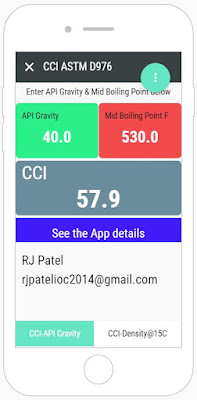- An App for Kin. Viscosity Calculator - blend of Petroleum Products

This App covers the kinematic Viscosity in cSt units, blending of petroleum products. Range of viscosity here is for diesel fuels however, it can cover larger range. Readers may like to try and comment. As most of readers aware, viscosity is not additive property like say density or Sulphur content in petroleum products. The principle is based on viscosity index as explained in my article published earlier. App for blending petroleum products for density, Sulphur Content, Benzene Content, etc (Additive properties) may be accessed here. Similar Apps on Petroleum Calculations developed by RJ Patel- see here. Kin. Viscosity blend Calculator You can obtain this app by writing to rjpatelioc2014@gmail.com. Author's Profile clik here. List of all blog articles on Petroleum QC by RJ Patel. rjpatelioc2014@gmail.com Follow me on twitter @RJPatel13 to get notification when my new post is available in my blog. Keywords:









